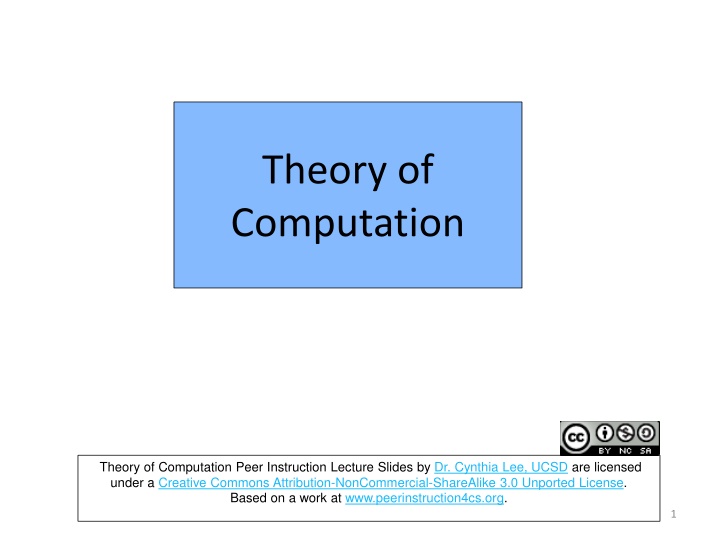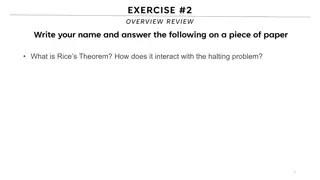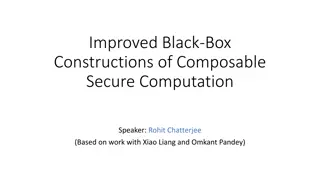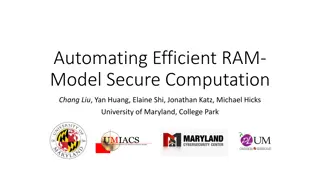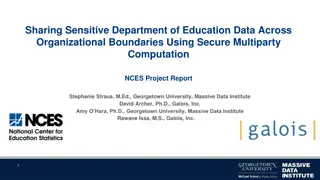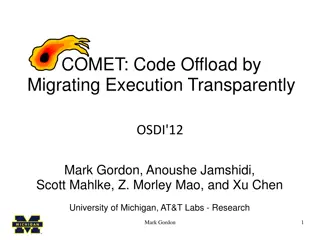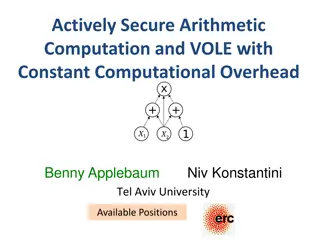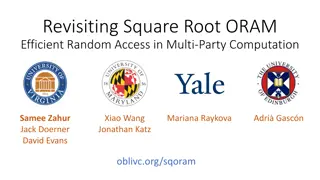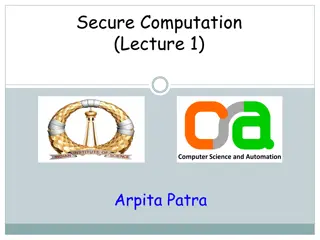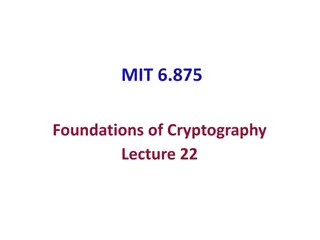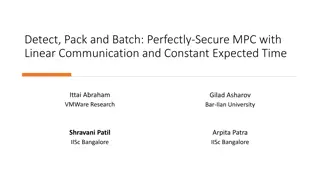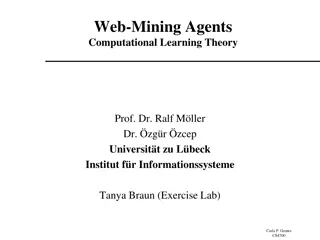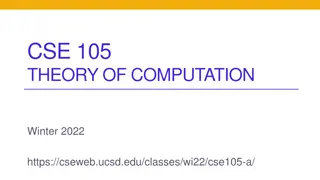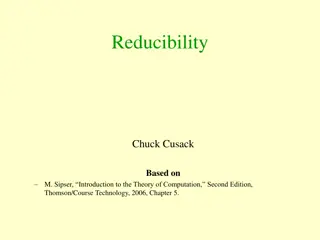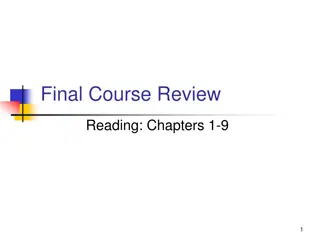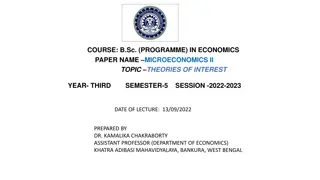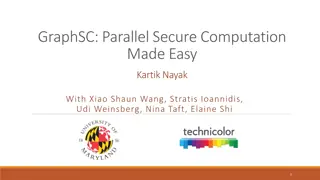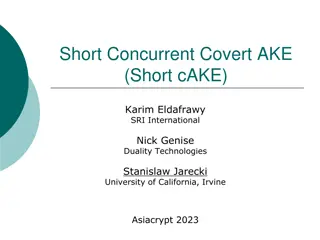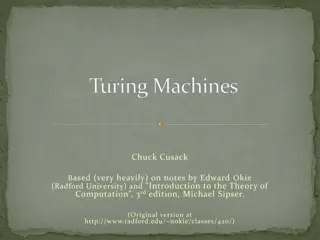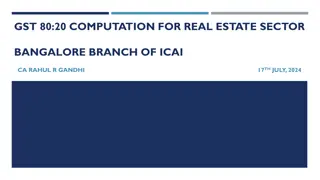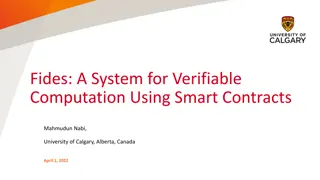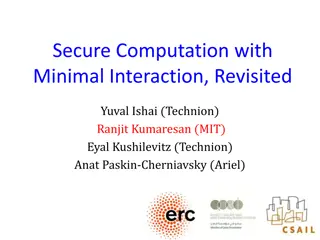Theory of Computation
In this insightful collection, delve into the groundbreaking contributions of Alan Turing, the father of computer science. Explore his pivotal role during WWII in cracking the Enigma code, his pioneering work in artificial intelligence, and the enduring legacy of his Turing Test. Witness Turing's enduring impact on the field of computation and the acknowledgment of his tragic history amidst societal prejudices. Uncover the profound influence of Turing's theories and machines that continue to shape modern computing.
Download Presentation

Please find below an Image/Link to download the presentation.
The content on the website is provided AS IS for your information and personal use only. It may not be sold, licensed, or shared on other websites without obtaining consent from the author.If you encounter any issues during the download, it is possible that the publisher has removed the file from their server.
You are allowed to download the files provided on this website for personal or commercial use, subject to the condition that they are used lawfully. All files are the property of their respective owners.
The content on the website is provided AS IS for your information and personal use only. It may not be sold, licensed, or shared on other websites without obtaining consent from the author.
E N D
Presentation Transcript
Theory of Computation Creative Commons License Theory of Computation Peer Instruction Lecture Slides by Dr. Cynthia Lee, UCSD are licensed under a Creative Commons Attribution-NonCommercial-ShareAlike 3.0 Unported License. Based on a work at www.peerinstruction4cs.org. 1
Father of Computer Science FAMOUS PEOPLE: ALAN TURING
Famous People: Alan Turing Father of Computer Science Born in England in 1912 Studied at University of Cambridge (UK) Contributions to: Computer Science Logic Artificial Intelligence Cryptography 3
During WWII German Enigma machine was used to send sophisticated encrypted messages Cracking the Enigma code a major factor in course of the war First cracked by Polish investigators, who shared techniques with England Turing and others devised further ways of detecting configurations Allowed England to know which cities were going to be bombed, U-boat whereabouts, etc Enigma configuration rotors 4
Artificial Intelligence In this Jeopardy! challenge, the identities were not hidden, so it was not a Turing Test format. But it was a remarkable display of the kind of power that Turing predicted machines could have. How will we know if/ when computers have achieved enough sophistication to be called intelligent? Alan Turing proposed the Turing Test A human tester chats with a human and computer Can the tester reliably identify which is which? 5
Turings Three Major Contributions in this Course Turing Machine design Talk about this starting today (!!) Church-Turing thesis Halting problem undecidability Talk about these over the next two weeks Current Events In 2009, British government issued a formal apology for its persecution of Turing, which may have led to his suicide at just 41 years old Alan Turing was a gay man, and homosexuality was crime in England at that time Government forced him to undergo treatments with terrible side effects 6
At last we reach: TURING MACHINES 7
Why do we care about Turing Machines? All modern computers follow the Turing Machine model CPU = TM control Memory = TM tape This division seems obvious now, but is the core of Turing s model Our memory isn t infinite Theoretical analysis of TMs answers the question: what kinds of problems could we solve (or can t we solve), if we didn t have to worry about memory limitations (sometimes with cloud computing it feels like we re almost to that point!) Memory can include all levels of the memory hierarchy (more about this in CSE 141): RAM, disk, etc 9
Turing Machine Formal Description In the TM transition function : Qx -> Qx x{L,R}, in other words, a given input of the transition function is: a) A current state, a character read, and whether we came from the left or right b) A current state, a character read c) A current state, a character to write d) A destination state, a character read e) None of the above or more than one of the above 10
Turing Machine Formal Description In the TM transition function : Qx -> Qx x{L,R}, in other words, a given output of the transition function is: a) A current state, a character read, and whether we came from the left or right b) A current state, a character to write, and whether we should next go left or right c) A destination state, a character read, and whether we should write L or R d) A destination state, a character to write, and whether we should next go left or right e) None of the above or more than one of the above 11
Executing a Transition, yields Suppose we have at TM s.t. ={a,b,c,d,_}, Q = {qx | 1 x 10} U {qacc,qrej}, and the transition function includes rules (q1,a) = (q3,b,R) and (q1,b) = (q3,a,L). We also have strings x,y in *. Which configuration does the current configuration, xbq1ay, yield? a) xq3bay b) xbbq3y c) xbaq3by d) xq3aay e) None of the above or more than one of the above 12
Executing a Transition, yields Suppose we have at TM s.t. ={0,1,_}, Q = {qx | 1 x 7} U {qacc,qrej}, and the transition function includes rules (q2,1) = (q1,0,R) and (q2,0) = (q1,1,L). We also have strings x,y in *. Which configuration does the current configuration, x0q21y, yield? a) xq101y b) x01q1y c) x00q1y d) xq111y e) None of the above or more than one of the above 13
Executing a Transition, yields Suppose we have at TM s.t. ={a,b,c,d,_}, Q = {q1, q2, q3, q4,qacc,qrej}, and the transition function includes rules (q2,c) = (q3,d,R) and (q2,d) = (q3,c,L). We also have strings u,v,x,y in *. Which configuration does the current configuration, xcq2dy, yield? a) xq3ddy b) xcdq3y c) xq3ccy d) xq3ccdy e) None of the above or more than one of the above 14
More Transition Function (a) TRUE (b) FALSE x0qrej11y yields x01q11y can never happen in any Turing Machine 15
